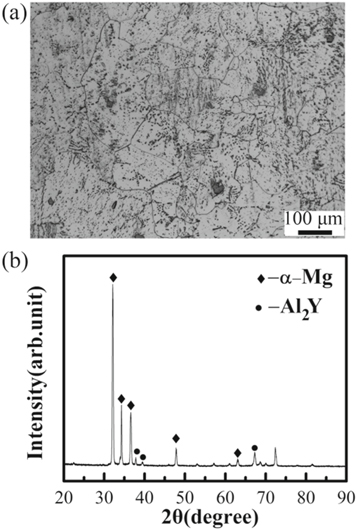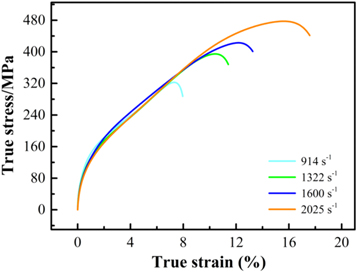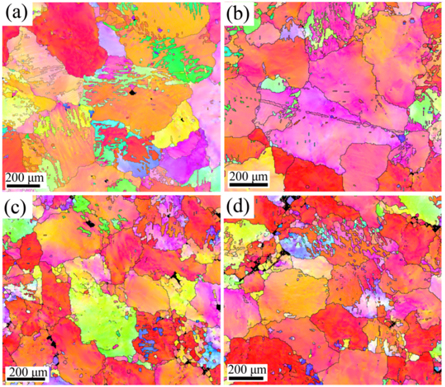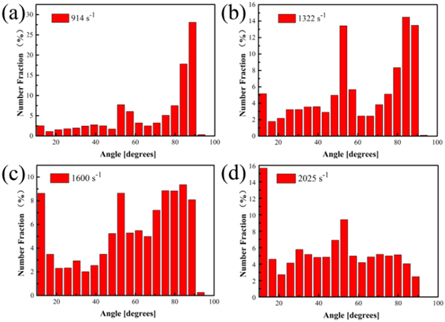Abstract
This study aims to investigate the deformation behaviours of Mg-1Al-4Y alloy by SHPB apparatus under different strain rates at room temperature. Texture evolution analysis of Mg-1Al-4Y specimens were carried out by X-ray diffraction and electron back-scattered diffraction technology. The macro-texture of the specimen in the transverse direction was gradually biased towards [20–21] with the increasing of the strain rate. Furthermore, a large amount of {10–12} extension twins formed in the grains at low strain rate, and partial twin-shaped nuclei grew up to meet, resulting in formation of boundaries with ∼60° misorientation. The grain boundary orientation distribution indicated that the grain size of Mg matrix became smaller and smaller with the growth of twins, which was not conducive to the continued nucleation of twins. Meanwhile, the rotation of grains decreased the Schmid factor of the twins, which led to an obviously reduction in the fraction of the twin nucleation. Therefore, the dynamic deformation mode of Mg-1Al-4Y gradually changed from twin deformation to twin deformation and dislocation slip with the increasing of strain rate.
Export citation and abstract BibTeX RIS

Original content from this work may be used under the terms of the Creative Commons Attribution 4.0 licence. Any further distribution of this work must maintain attribution to the author(s) and the title of the work, journal citation and DOI.
1. Introduction
Mg alloys have extensively application prospects in the fields of automotive and aerospace, due to their low density, excellent damping property and high specific strength [1–6]. These Mg alloy components often faced high speed impact, where commonly achieved very high strain rates [7–9]. At present, the mechanical behavior and deformation mechanisms of Mg alloys at low strain rates have been widely studied [9–14]. However, the deformation behavior and mechanical properties of Mg alloys under high strain rates are more complicated than those at low strain rates, and the deformation mode is no longer dominated by dislocation slip [15–19]. Therefore, it is important to study the dynamic mechanical properties and deformation mechanisms of Mg alloys components under high-speed impact conditions to ensure Mg alloys can be used in high-speed impact environments. Thus, proving significant guidance for the mechanical parameters and deformation mode of the Mg alloy components at high strain rates are basically to effectively prevent serious accidents such as breakage of these components in a high strain rate loading conditions, and increase the reliability and service life of magnesium alloy material components.
The dynamic properties and deformation behaviours of Mg alloys at different strain rates have been extensively studied in the past [20–25], such as AZ31, AZ91, AZ80. Liu et al [26] reported the effect of temperature on the anisotropic behavior of AZ31 Mg alloy rolling sheet under high strain rate compression deformation by using the split Hopkinson pressure bar (SHPB). The results indicated that the critical resolved shear stress (CRSS) for pyramidal 〈c+a〉 slip was the predominant slip mechanism for normal direction (ND), and decreased close to that of twins was the predominant deformation mechanism for rolling direction (RD) and transverse direction (TD). The mechanical properties of AZ31B along the ND under high strain rates were studied by using the SHPB apparatus by Zhang et al [27]. Lou et al [28] carried out detailed research on the twinning behavior and dislocation behavior of the as-rolled AZ31 sheet during high strain rate compression. It was found that the twinning is the main mode of plastic deformation, and the twinning behavior is affected by dislocations. Liu et al [29] carried out a detailed analysis of the influence of the rolling and annealing on deformation behavior of the as-rolled and annealed Mg-3%Li-1%Nd alloy by using the SHPB. However, there is few reports on dynamic behaviors of Mg-1Al-4Y alloys at different strain rates. It is essential to investigate the dynamic behaviors and deformation mechanisms of Mg-1Al-4Y alloys at high strain rates to acquire the micro-deformation mechanism of the material.
The dynamic behaviors and deformation of Mg-1Al-4Y alloy were studied by using SHPB. The influence of strain rate on the mechanical properties and deformation mechanism of Mg-1Al-4Y alloy were investigated. It was found that the flow stress and elongation of the Mg-1Al-4Y alloys were obviously improved with the strain rate increases. The microstructures and texture evolution of Mg-1Al-4Y alloy under high-speed impact were analyzed by XRD and EBSD techniques. A large amount of {10-12} extension twins formed in the grains at the impact strain rate of 914 s−1. The fraction of extension twin decreases and the fraction of contraction twin increases with the increasing of strain rate. As the growth of twins was inhibited, a large amount of dislocations was formed inside the grains and the contribution of dislocations to the deformation begins to rise. Eventually, the strength and plasticity of Mg-1Al-4Y were greatly improved.
2. Materials and Methods
The geometry of specimens was utilized for the high speed impact: cylindrical samples (length = 5 mm, length/diameter = 0.625), which was processed from the as-cast Mg-1Al-4Y alloy by using EDM PW2UP wire cutter. The schematic illustration of the SHPB apparatus and the measuring procedures was presented in figure 1. The specimen was used for the SHPB test, placed between incident bar and transmitted bar, which along with the impact interface. Hence, the true stress-strain curves were obtained at high strain rates. The power of bullet system of the Hopkinson pressure bar is provided by a fast release of compressed nitrogen, and a precise strain rate is accurately obtained by measuring the speed of the bullet with laser speed measurement. The dynamic impact tests were carried out by using a compressive SHPB equipment with different strain rates (dε/dt = 800 s−1–2500 s−1) at room temperature. Four tests were conducted by using SHPB apparatus, and the averages of the reported results were used to verify the repeatability of the experimental results. After the high strain-rate tests, macro-textures evolution of the samples under different impact strain rates was investigated by x-ray diffraction (XRD, XD8ADVANCE-A25X) with Cu Kα radiation. Furthermore, the microstructures of samples after deformation were observed by scanning electron microscope (SEM) with the electron back-scattered diffraction (EBSD) technology. In addition, the initial microstructure and phase structure of the alloy were observed and detected by a optical microscope (OM) and XRD, respectively.
Figure 1. The typical schematic of the SHPB test.
Download figure:
Standard image High-resolution image3. Results and discussion
3.1. Microstructure and mechanical property
Figure 2 shows initial OM microstructure and XRD pattern of the as-cast Mg-1Al-4Y alloy plate along the longitudinal section. It can be seen from figure 2(a) that there is a mass of small second phases (black contrast) distributed in the inner and boundary of the grains, and the initial grain size of α-Mg matrix is approximately 300 μm. As shown in figure 2(b), the XRD result showed that only α-Mg and Al2Y phases can be detected, and the α-Mg phase was the main phase. Figure 3 shows the tensile stress-strain curves of the as-cast Mg-1Al-4Y alloy at strain rate of 0.01 s−1, the tensile strength, yield strength (TYS) and elongation are 143.3 MPa, 65.33 MPa, 10.3%, respectively.
Figure 2. (a) Initial OM photograph from the longitudinal section of the as-cast Mg-1Al-4Y alloy plate; (b) XRD pattern of Mg-1Al-4Y alloy.
Download figure:
Standard image High-resolution imageFigure 3. Tensile stress-strain curves of the Mg-1Al-4Y alloy.
Download figure:
Standard image High-resolution imageThe Mg-1Al-4Y alloy samples were characterized by SHPB with different strain rates at room temperature (shown in figure 4). It was found that the flow stress and elongation of the Mg-1Al-4Y alloy were significantly improved with the increasing of strain rates, which indicated that the increasing of strain rate has a great influence on the strength and plasticity of material. The flow stress and elongation of Mg-1Al-4Y is 478.5 MPa and 16.6% at strain rate of 2025 s−1, which increased 48.7% and 124.3% than that of at strain rate of 914 s−1, respectively. The flow stress and elongation of Mg-1Al-4Y at strain rate of 914 s−1 were increased 124.6% and −28.2% than that of in tensile test. Therefore, the flow stress of the samples is greatly improved during high-speed impact. When the strain rate is less than 1322 s−1, the plastic strain of the material is lower than the value of the tensile test. That is because the modes of deformation are mainly slip and dislocation in the tensile test of Mg-1Al-4Y alloy, the deformation is mainly twinning deformation at low strain rate during high-speed impact. When the strain rate is greater than 1500 s−1, the deformation modes of the Mg alloy except for twinning, the basal slip and the prismatic slip begin to start to coordinate deformation. Therefore, the plasticity of material is greatly improved.
Figure 4. Stress - strain curves with varied strain rates at 293 K.
Download figure:
Standard image High-resolution image3.2. Analysis of texture evolution
Texture evolution analysis of Mg-1Al-4Y alloys specimens were studied by XRD, and the effect of impact strain rate on the microstructure of the specimens was investigated and complement of the results obtained by EBSD technology. Figure 5 shows (0002) and (10-10) pole figures (PF) and inverse pole figure (IPF) of the deformed samples at room temperature with the strain rate of 914 s−1, 1322 s−1, 1600 s−1, and 2025 s−1, respectively. Wherein the X direction represents the impact direction (ID), Y represents the TD, and Z represents the ND. It is found that the strong pole density points formed a basal texture at both ends of the ID after high-speed impact (from figure 5(a)). Most of the crystal axis is deflected to a position of 15 degrees from the ID direction. Therefore, the Mg-1Al-4Y alloys exhibit a relatively strong {0001} basal texture after high-speed impact, while the {10-10} prismatic plane does not form a clear preferred orientation. It can be seen from the IPF of the ND direction that the macroscopic a-axis of the specimens is mainly biased towards the [11-21] orientation, and the overall appearance of the specimens is (0002)[11–21] texture (from figure 5(b)). From the results of figures 5(c)–(h), it is found that the pole density points at both ends of the ND direction are strengthening, and the pole density points in other regions are weakening. The c axis of most grains is roughly parallel to the ID, which indicates that the twin texture is enhanced with the strain rate increases. It can be seen intuitively that the weak pole density points appear at both ends of the TD, which indicates that the a-axis also rotates to a certain extent during the rotation of the grains, which are parallel to the TD. Therefore, the prismatic of the grain is deflected perpendicular to the TD. As the increasing of strain rate , the macro-texture of the specimen in the TD is more biased towards [20, 21], and the type of texture formation is (0002)[20, 21].
Figure 5. PF and IPF of the samples under different impact strain rates: PF (a) 914 s−1, (c)1322 s−1, (e) 1600 s−1, (g) 2025 s−1; IPF (b) 914 s−1, (d)1322 s−1, (f) 1600 s−1, (h) 2025 s−1.
Download figure:
Standard image High-resolution imageThe microstructure and texture of Mg-1Al-4Y alloy are obtained by EBSD and shown in figure 6. Grain orientation distribution maps with different strain rates were obtained by EBSD, and the strain rates was 914 s−1, 1322 s−1, 1600 s−1 and 2025 s−1, respectively. The grains are colored based on those crystal orientations and a larger amount of different colors reveal a wider spectrum of orientations. The texture intensity can be estimated with the increasing fraction of colored grains. It can be seen from the grain orientation distribution that the grain orientation is obvious and the grain boundaries are clear. The basal texture shows a trend of strengthening with the increasing of strain rates. It was also found that the coarser grains of Mg-1Al-4Y alloy are divided and refined after high-speed impact. The grain size of Mg matrix first increases and then decreases with the increasing of strain rate. The same result is obtained from the statistical diagram of grain distribution in figure 7.
Figure 6. Grain orientation distribution map of Mg-1Al-4Y alloy with different strain rates at room temperature: (a) 914 s−1; (b) 1322 s−1; (c) 1600 s−1; (d) 2025 s−1.
Download figure:
Standard image High-resolution imageFigure 7. distribution of grain size Mg-1Al-4Y alloy under different strain rate at room temperature. (a) 914 s−1 (b) 1322 s−1 (c) 1600 s−1 (d) 2025 s−1.
Download figure:
Standard image High-resolution imageThe c-axis of the grains perpendicular to the load direction deflect and approximately parallel to the impact direction during the high speed impact, which forms a twin texture. The twin texture hardening greatly improves the mechanical properties of the Mg-1Al-4Y. Figure 8(a) is the PF results of the Mg-1Al-4Y at 914 s−1, which are the (0001), (1010), (10-11) and (11-20) pole figures. It is easy to find that a strong pole density point is formed along the ID direction, which indicates that the crystal c-axis of the most grains are deflected parallel to the ID. The prismatic pole figure indicate that a weak pole point is formed in the TD direction deviating from 30°. The (0002)[2-1-10] basal texture are formed. The results show that the twins have occurred in all specimens under high speed impact but the twin fractions are different. It can be seen from figures 8(b)–(d) that the pole density point becomes closer to the TD direction with the strain rate increases. The c-axis of the Mg-1Al-4Y alloy grains gradually deflects toward the ID direction, the basal texture becomes more and more obvious, and the volume fraction of twins becomes larger and larger. With the further increasing of the strain rates, the a-axis of the grain continues to rotate and gradually parallel to the TD direction. The prismatic plane of the Mg alloy samples is perpendicular to the TD, and the crystal shows a texture of (0001)[20-21]. This is consistent with the macro-texture obtained by XRD.
Figure 8. Inverse pole figure maps and image quality maps of the samples showing the twins type and distribution after shock loading of OP samples under different strain rates: (a) 914 s−1; (b)1322 s−1 (c) 1600 s−1(d) 2025 s−1.
Download figure:
Standard image High-resolution imageIt can be found from the orientation distribution diagram of figure 9(a) that the orientation difference forms a peak around 86°, and the large-angle grain boundary accounts for about 30% of the total number. It is indicated that a large number of twin structures are formed inside the sample. It can be seen from the Hell-Petch formula that the coarse grains cause a large stress concentration, which is more likely to cause the formation of twins. The characteristic of twinning formation is to maintain a strict relationship between habit surfaces and habits relation, and the orientation difference determined by counting the habit surfaces and directions generated by all twins, in order to infer the type of twin formation through the orientation difference. The peak of the orientation distribution map of those samples appears near 86°. It can be judged that the twins generated during the impact of the sample are mainly {10-12} extension twins. From the orientation distribution map, it can be found that a weak diffraction peak is also formed near 60°. The appearance of this angle peak is related to the encounter of the variants after the twins grow up. As the amount of deformation increases, the twins grow rapidly into nuclei, the encounter of different twin variants leads to an increase in orientation around 60°, and irregular twins are formed in some areas. The basal slip is the dominant slip system due to the low CRSS at room temperature. {10-12} extension twinning is another dominant deformation mode due to its lower initiation CRSS [30, 31], which reorients the basal plane by 86°, activates more slips systems and refines the grain size by {10-12} twin subdivision [32, 33]. Extension twinning is favored when the c-axis is under tension, which accommodates tensile deformation in the c direction and reorients the twinning by approximately 86.3°. Contraction twinning is preferred when the c-axis is under compression, which accommodates compressive deformation in the c direction and reorients the twinning by approximately 56.2°. Thus, the number of extension twins decreases with increasing of strain rates, while the number of contraction twins increases with increasing of strain rates.
Figure 9. Misorientation angle distribution map. (a) 914 s−1; (b) 1322 s−1; (c) 1600 s−1; (d) 2025 s−1.
Download figure:
Standard image High-resolution imageIt can be seen from figure 10 that the large angle grain boundary accounts for a high proportion (46.22%) at the impact strain rate of 914 s−1, indicating that a large number of extension twins form in the grains. Partial twin-shaped nuclei grow up to meet and result in formation of boundaries with ∼60° misorientation [34]. The proportion of the small angle grain boundary is very little, only about 3.64%. The large-angle grain boundary is less and less with the strain rate increases. When the strain rate reached 2025 s−1, the proportion of large-angle grain boundaries decreased to 6.54%. The proportion of small-angle grain boundaries increased rapidly, reaching 20.25%. It shows that the contact area between the twins and the matrix is constantly decreasing, and the volume fraction of the twins is increasing with the strain rate increases. The grain size of matrix becomes smaller and smaller with the growth of twins, which is not conducive to the continued nucleation of twins. Meanwhile, the rotation of the grains decreases the Schmid factor of the twins, which leads to a significant reduction in the number of the twin nucleation. The twins continue to grow and gradually replace the matrix structure, and the large-angle grain boundaries are also decreasing. With the growth of twins is suppressed, a large amount of dislocations is formed inside the grains and at the edges of the twins, and the contribution of dislocations to the deformation begins to rise. Therefore, the proportion of the small-angle grain boundary difference rises rapidly. As the strain rate continues to increase, the proportion of small-angle grain boundaries gradually increase, the twin grain boundaries around 86° show a downward trend. This result is consistent with the results of changes in the flow stress and elongation of the material during high-speed impact.
Figure 10. the grain boundary orientation distribution of different strain rates at room temperature. low angle ≤15°, medium angle 20°–80°, high angle ≥85°.
Download figure:
Standard image High-resolution image4. Conclusions
The Mg-1Al-4Y alloy samples were characterized by SHPB with different strain rates. It is found that the flow stress and elongation of the Mg-1Al-4Y alloy are significantly improved with the strain rates increasing, which indicates that the increasing of strain rates has a positive effect on the strength of material. It is found that the strong polar points formed a basal texture at both ends of the ID after high-speed impact. The results of the IPF of the ND direction reveal that the overall appearance of the specimens is (0002)[11-21] texture. As the strain rate increases, the macroscopic texture of the specimen in the TD direction is more biased towards [20-21], and the type of texture formation is (0002)[20-21]. The large angle grain boundary accounts for a high proportion at the impact strain rate of 914 s−1, which indicated that a large number of {10-12} extension twins form in the grains. Partial twin-shaped nuclei grow up to meet and result in formation of boundaries with ∼ 60° misorientation, the large angle grain boundaries become less and less with the increase of strain rate. When the strain rate reached 2025 s−1, the proportion of large-angle grain boundaries decreased to 6.54%, while the proportion of small-angle grain boundaries increased rapidly, reaching 20.25%. It shows that the contact area between the twins and the matrix is constantly decreasing, and the volume fraction of the twins is increasing with the strain rate increases. The grain size of matrix becomes smaller and smaller with the growth of twins, which is not conducive to the continued nucleation of twins. Meanwhile, the rotation of the grains decreases the Schmid factor of the twins, which leads to a significant reduction in the number of the twin nucleation. The twins continue to grow and gradually replace the matrix structure, and the large-angle grain boundaries are also decreasing. With the growth of twins is suppressed, a large amount of dislocations is formed inside the grains and at the edges of the twins, and the contribution of dislocations to the deformation begins to rise. Therefore, the {10-12} extension twins are the main deformation mode at low strain rate, and the plasticity and strength of the Mg-1Al-4Y are small. While the main deformation methods are contraction twin and dislocation slip at high strain rates, and the plasticity and strength of the materials are large.
Acknowledgments
This research was sponsored by Qinghai Provincial Basic Research Program (2020-ZJ-707).











